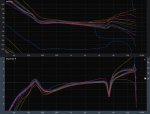Re: DSP Tower of Babel
I am guilty of promoting the view that these platforms should be more consistent, so mea culpa.
It looks like there are more errors than the one or two I expected (lack of standard definition for Q, and top octave sample rate interactions).
This looks like platforms may be indiscriminately mixing and matching FIR and IIR filters with little consideration for how they differ in practice. Surely the manufacturer preset curve we are trying to replicate intended a specific response (amplitude and phase).
Besides that just the basic accuracy of these platforms appear to be lacking. I am surprised that the errors are not localized to my simple Q vagueness, but just about everything else, while the combination of all the different filters makes it harder to parse out what exactly is wrong. (note for Bennet's AES paper, plot each individual filter by itself.)
We need to name names and hopefully embarrass some of these people into cleaning up their act.
If the same manufacturer doesn't even agree with themselves between different models I submit they have a problem. This may be as innocent as the later release correcting an error in the earlier model, or just gross sloppiness. If they are too cheap to go back and correct the earlier model, they could list a correction factor on their website. If they don't know which one is right (if either) they are justified in keeping mum. :lol:
I am still optimistic that we will eventually get to enjoy the promise of digital consistency, but apparently not today, not yet. :roll:
JR
I am guilty of promoting the view that these platforms should be more consistent, so mea culpa.
It looks like there are more errors than the one or two I expected (lack of standard definition for Q, and top octave sample rate interactions).
This looks like platforms may be indiscriminately mixing and matching FIR and IIR filters with little consideration for how they differ in practice. Surely the manufacturer preset curve we are trying to replicate intended a specific response (amplitude and phase).
Besides that just the basic accuracy of these platforms appear to be lacking. I am surprised that the errors are not localized to my simple Q vagueness, but just about everything else, while the combination of all the different filters makes it harder to parse out what exactly is wrong. (note for Bennet's AES paper, plot each individual filter by itself.)
We need to name names and hopefully embarrass some of these people into cleaning up their act.
If the same manufacturer doesn't even agree with themselves between different models I submit they have a problem. This may be as innocent as the later release correcting an error in the earlier model, or just gross sloppiness. If they are too cheap to go back and correct the earlier model, they could list a correction factor on their website. If they don't know which one is right (if either) they are justified in keeping mum. :lol:
I am still optimistic that we will eventually get to enjoy the promise of digital consistency, but apparently not today, not yet. :roll:
JR

